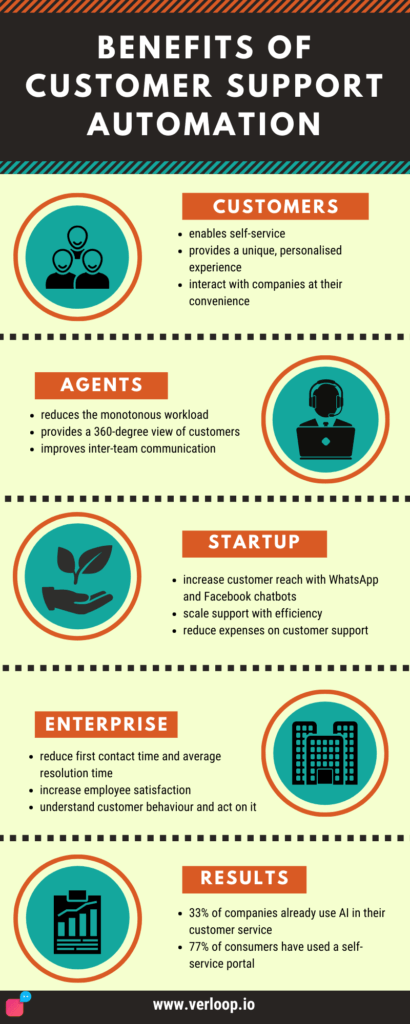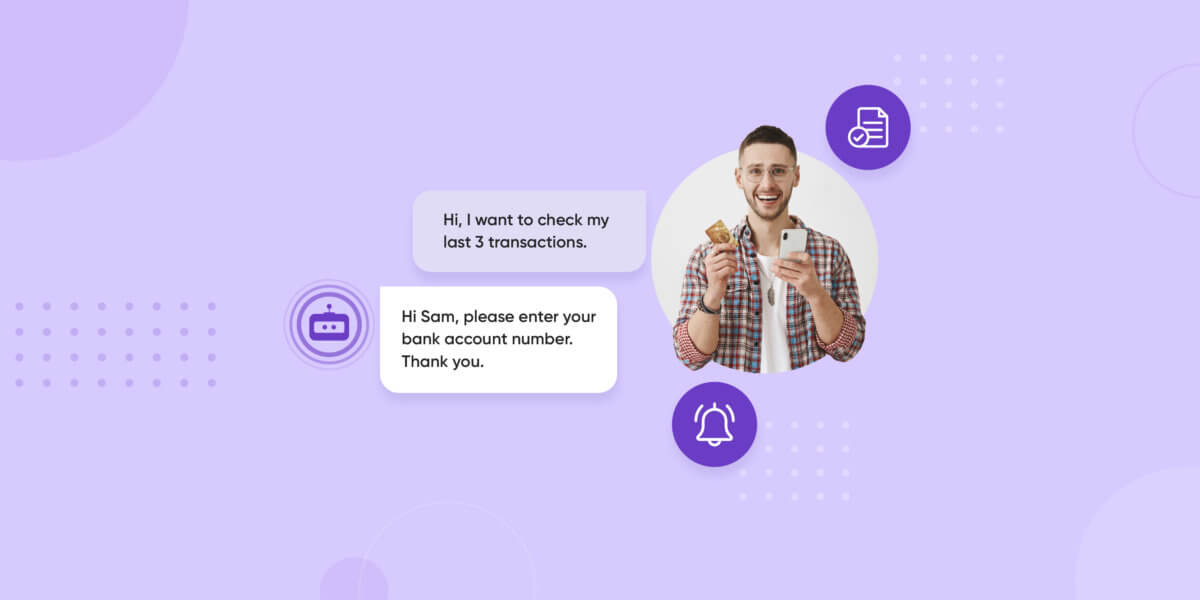Customer Support Automation: Benefits and Results
- July 2nd, 2025 / 5 Mins read
-
Aarti Nair

Customer Support Automation: Benefits and Results
- July 2nd, 2025 / 5 Mins read
-
Aarti Nair
Businesses of all sizes are automating customer support to scale and improve consumer interactions. The benefits are plenty and bearing results already.
Your support team spends hours answering routine queries like refund requests, shipping updates, and password resets, while more complex issues pile up. What if you could offload those basic questions to an AI customer support bot, freeing agents to tackle the thornier problems?
That’s the promise of customer support automation.
Research from MIT Sloan shows that people using generative AI tools boost their performance by 40% over those who don’t. And McKinsey puts the global upside at up to $4.4 trillion a year, thanks to smarter workflows and faster problem-solving. No wonder Gartner finds that 80% of companies will have AI-powered chatbots handling customer service by 2025.
Take the case of any online retailer (We interviewed a few support teams to understand) before automation, their team fielded thousands of “Where’s my order?” emails each week. Now, an AI bot settles 70% of those in seconds, cutting response times from hours to minutes. Meanwhile, human agents focus on high-value interactions, boosting satisfaction scores and driving repeat business.
In the sections that follow, we’ll explore how customer support automation and AI customer support can sharpen your operations, from 24/7 chatbot coverage and personalised self-service to seamless hand-offs when a human touch is needed. Ready to reduce repetitive work and delight customers without breaking the bank? Let’s get started.
So, What is Customer Support Automation?
What is Customer Support Automation?
Customer support automation uses technology to replace repetitive tasks and streamline processes to reduce human involvement, assist agents and customers and reduce operational costs and time taken to complete a task. Companies can use various technologies (for example, chatbots, voice assistants, and other AI-powered tools) to accomplish this.
What Is AI Customer Support?
AI customer support uses software agents like chatbots or voice bots to handle routine enquiries and tasks that would otherwise fall to human agents. Think of it as a virtual assistant that can:
-
Answer FAQs instantly: Whether it’s “What’s my account balance?” or “How do I reset my password?”, an AI bot delivers accurate answers in seconds.
-
Process simple transactions: Bots can initiate returns, schedule appointments or transfer funds without human intervention.
-
Provide 24/7 availability: No more “our office hours are 9–5”—an AI agent never takes a break.
Unlike traditional rule-based scripts (those old “press 1 for… press 2 for…” menus), modern AI customer support relies on natural language understanding. That means you can type or speak a full sentence (“I’d like to change my delivery address”) and the bot grasps your intent, asks follow-up questions if needed, and completes the task.
For example, a travel company’s AI bot might guide a passenger through rebooking a missed flight mid-journey, checking seat availability and confirming payment—all in under a minute. At the same time, human agents are freed up to handle complex issues like international visa queries or group bookings.
By automating repetitive, time-consuming tasks, AI customer support boosts efficiency and ensures your team can focus on the tricky cases that truly need a human touch.
Benefits of Automating Support with AI Customer Support
As companies grow, giving attention to each customer becomes laborious. Enterprise businesses usually outsource their support to call centres and contact centres, however, it is expensive and outdated. On the other hand, startups don’t have the right resources and end up with unsatisfied customers as well.
Implementing automation in customer service has many perks. To start with, it reduces an agent’s workload by automating redundant and mundane tasks. This in itself reduces operational costs and improves employee satisfaction. Other than this, it increases customer touchpoints, provides omnichannel experience, personalises conversations, sheds light on customer behaviour, scales support and brings down first contact time drastically.
Suggested Reading: How startups can track their classic support metrics through customer support automation
Automating Support Rewards Customers
A point often overlooked is that support automation gives customers unique experiences. Conversational AI hyper-personalises a customer’s interaction depending on the channel/page they start the conversation, demographic and geographic information and customer’s buying journey stage. Every conversation is one-of-it’s kind.
Then there are other benefits like empowering customers with hassle-free self-service. According to a Forrester study, two-thirds of customers want self-service. By automating frequently asked questions, consumers can solve straightforward issues by themselves, at their convenience. Notably, it drives engagement and increases customer satisfaction level.
Customers can also reach out to companies on a platform of their choice. By integrating WhatsApp, Facebook Messenger, website or the mobile app with the customer support platform, companies can extend their services to these platforms. As a result, companies can get closer to their consumer through automated service support.
Suggested Reading: Automation Is The Next Big Thing In Customer Support
Agents Perform Better with Support Automation
And while customers are happy with self-service, the load on support agents reduces. Consequently, they can shift focus on complex queries that require extra attention and skill. For example, AbhiBus deflected 96% of queries coming to agents and improved their productivity by 33%.
Suggested Reading: AbhiBus Achieved 33% Increase In Agent Productivity After Moving To Live Chat Service
Moreover, customer support automation platforms provide agents with a 360-degree view of consumer information. Due to this, they get a high ground to quickly and accurately resolve tickets. Automation platforms allow integration with most CRMs and other tools to fetch relevant customer data and show them in one screen.
Likewise, customer support automation platforms make inter-team communication easy. It updates data in real-time and directs the query to the right department. Automated processes reduce human errors and let the business function smoothly.
Automate Support with AI to Enrich Customer Experience
Steve Jobs once famously said ‘People don’t know what they want unless you give it to them.” And this couldn’t be more true in customer service. If you could understand customer behaviour and give the customer exactly what they want even before they could ask, wouldn’t it be great?
Artificial Intelligence (AI) with deep learning models can do just that for you.
A smart AI software can record every interaction a customer has with your brand, identify trends and highlight patterns in their behaviour. Based on these patterns, you can show them the right ad or send the right message at the right time.
Suggested Reading: Faster, Smarter, Better — AI Is Improving Customer Service
On the other hand, if there is any deviation from the pattern, AI can flag it and you can take action as required to provide a seamless customer experience.

Here’s something productive for you – Download customer support automation ebooks
Startups Increase Engagement
When a company starts out, they don’t have resources or budget to compete with bigger companies. Startups can leverage automation software to provide consistent, personalised support. They can scale it with their growth and interact on customer’s preferred channels.
Small companies can connect faster with their customers on platforms like WhatsApp and Facebook Messenger. The customers get a 24×7 instant response, the agents get notified immediately and the overall experience improves overall.
A smart, conversational, automated support platform can be the one-stop place for everything support for a startup. From answering questions to getting feedback, from assisting customers in decision-making to purchasing products on the chatbot. All this at a fraction of the cost of outsourcing this service to call centres.
Suggested Reading: Call Centre is Dead. Automated Customer Support is the Future.
Enterprise Enhancing Customer Experience
Big corporations have their own challenges when it comes to customer support. Customers are left waiting on the line for a long duration before they get connected with an agent. And when they do, they are transferred to different departments, having to repeat themselves again and again. Plus, the process isn’t personalised, leaving the customer dejected.
Enterprises can benefit greatly from customer service automation. For one, they can personalise interactions on different levels. But more importantly, they can reduce first contact time and the average resolution time for tickets. On average, chatbots can deflect up to 80% of questions, bypassing the need for an agent. And for the remaining 20%, it can handover the query to an agent who is online, thereby reducing the wait time.
One of the biggest advantages of customer support automation is the amount of time and capital companies can save. Big companies spend a lot on hiring and training support agents and yet they see a high attrition rate. In fact, the agent’s frustration often shows in their customer interaction, which isn’t good for the brand image or customer experience.
Customer service automation can solve this problem in two ways. First, it can improve employee happiness by reducing their amount of work on monotonous tasks and increasing meaningful work. Second, automation software is a one-time investment and reduces additional expenses. It also makes customer interactions consistent.
Suggested Reading: Save Money By Switching to Customer Support Automation
How to Automate Customer Support
Ready to offload repetitive tasks and let your team focus on complex queries? Follow these seven key steps to implement AI customer support smoothly and effectively:
1. Identify High-Volume Questions
Which enquiries swamp your agents daily?
Pull your top five ticket categories like “Where’s my order?”, “Reset my PIN” or “Claim status update.” Automating these will have the biggest immediate impact.
2. Select the Right AI Platform
Look for natural-language understanding, omni-channel coverage (chat, email, voice) and easy integration with your CRM or ticketing system.
At Verloop.io, our RAG engine even ingests PDFs, Word docs and spreadsheets to power context-rich responses.
3. Design Customer-Centric Flows
Map out each conversation from greeting to resolution:
-
-
Intent capture: “How can I help you today?”
-
Clarification: “Which order number are we tracking?”
-
Solution: “Your shipment is due tomorrow.”
-
Fallback: “Let me connect you to an agent.”
-
4. Train on Real Conversations
Feed your bot transcripts—complete with typos and slang—to teach it how real customers ask questions. A well-trained bot reduces confusion and cuts fallback rates.
5. Integrate Core Systems
Connect your AI to back-end services:
-
-
CRM for personalised greetings and data lookup
-
Booking or claims systems for real-time status updates
-
Payment gateways for refunds or balance checks
-
6. Monitor Performance Metrics
Track containment rate (bot-handled tickets), fallback rate (hand-offs to humans) and average response time. If containment stalls below your target, refine your knowledge base or conversation scripts.
7. Iterate with Customer Feedback
Ask “Was this helpful?” after key interactions. Use that feedback to add new intents—perhaps “How do I apply a discount?”—and continuously improve your bot’s accuracy and usefulness.
Automated Customer Service Yielding Results
Still on the fence about customer support automation? The data speaks for itself:
-
Regulatory push: The Reserve Bank of India has urged banks to adopt AI to address consumer complaints and enhance services. Are you ready to meet—and exceed—those expectations?
-
Industry momentum: EY reports that banks nationwide are leveraging AI to automate processes, resolve customer issues faster, and free up staff for high-value work.
Here’s what happens when AI takes the wheel:
1. 30% Lower Operational Costs
By automating routine ticket handling and self-service FAQs, organisations see up to a 30% drop in service-desk expenses. Fewer manual handovers and faster resolutions mean leaner budgets without sacrificing quality.
2. Up to 90% Labour Savings
Dialzara data shows AI can cut labour costs by as much as 90%, automating everything from order-status checks to appointment bookings. That’s a massive shift in how your team’s time—and your payroll—gets allocated.
3. 65% Time Back for Agents
With bots tackling repetitive questions, human agents reclaim 65% of their workday for complex problem-solving and relationship building. The result? Higher job satisfaction, lower turnover, and more meaningful customer interactions.
4. Data-Driven Service Improvements
AI not only responds—it learns. By analysing every chat and call, your support system uncovers patterns in customer pain points and product feedback. Those insights feed directly into training, process tweaks and upsell strategies, boosting satisfaction and conversion rates alike.
If you’ve ever wondered whether AI customer support is worth the investment, these numbers should put your mind at ease. When automation cuts costs, rescues agent bandwidth, and delivers actionable insights, it’s not just a technology upgrade—it’s a business transformation.
Ready to see these results in your own workflow?
Get in touch and let Verloop.io show you what truly automated customer service looks like.
FAQs: Automating Customer Support with AI
1. What is the first step in implementing AI customer support?
Begin by analysing your support logs to identify the top high-volume queries—such as order tracking or password resets—and target those for automation.
2. How much can AI reduce my support costs?
Organisations typically see a 30% decrease in operational service costs and up to 90% savings on routine labour by automating FAQs and simple transactions.
3. Which metrics should I track after deployment?
Key indicators include containment rate (percentage of tickets resolved by the bot), fallback rate (hand-offs to human agents), and average response time. Monitoring these in real time lets you optimise continuously.
4. Can AI bots handle sensitive tasks like payments or account changes?
Yes—when integrated securely with your payment gateways and account management systems, bots can process refunds, update account details and log transactions, all while maintaining compliance.
5. How do I ensure a smooth hand-off to live agents?
Design your conversation flows with clear fallback triggers. When a query exceeds the bot’s scope, it should transfer the full context—transcript, customer data and attempted steps—to the agent automatically.
6. What level of technical expertise is required to set up AI support?
Modern AI platforms offer low- or no-code interfaces. Basic tasks—importing FAQs, mapping simple flows—can be done by non-technical staff, while deeper integrations benefit from collaboration with IT teams.
7. How quickly can I expect a return on investment?
Many businesses see measurable ROI within 3–6 months post-launch, driven by reduced ticket volumes, faster resolution times and improved agent productivity.







